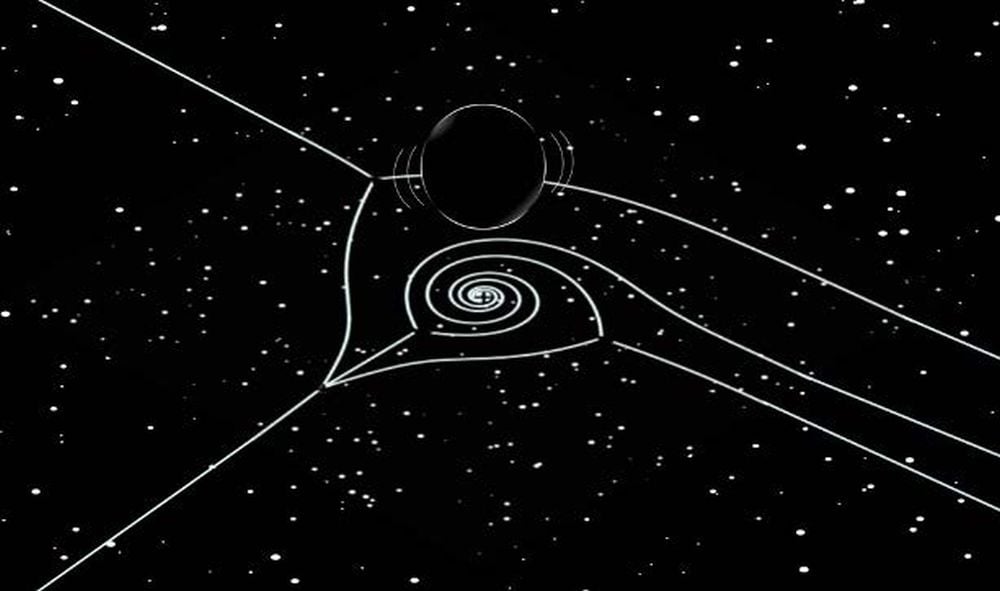Science
Scientists Uncover New Insights into Black Hole Vibrations

Research from Kyoto University has revealed new insights into the complex vibrations of black holes, enhancing our understanding of these cosmic phenomena. The study, led by physicist Taiga Miyachi, examines the oscillations emitted by black holes when they are disturbed, known as Quasinormal Modes (QNMs). These vibrations are critical for astrophysicists as they provide essential information about black holes, including their mass and shape.
When black holes merge, they produce specific QNMs that can be detected from Earth. This detection presents an opportunity for scientists to gain knowledge about black holes, which are notoriously difficult to study due to their nature. While traditional methods involve observing the dynamics of stars orbiting black holes, this new research aims to simplify the measurement of black hole masses through advanced mathematical techniques.
Innovative Measurement Techniques
The study, published in the March 2025 issue of Physical Review D, introduces a novel approach using the Wentzel–Kramers–Brillouin (WKB) method. This mathematical technique, while well-established, has not been widely applied in the context of black holes until now. The authors assert, “To our knowledge, this is the first concrete application of the exact WKB analysis to the black hole perturbations.”
Miyachi noted the cultural significance of the WKB method, stating, “The foundations of the exact WKB method were largely developed by Japanese mathematicians. As a researcher from Japan, I have always found this field intellectually and culturally familiar.” The researchers successfully tracked the wave patterns of black holes in greater detail than previous methods allowed, revealing complex structures previously overlooked.
Revealing the Complexity of Black Holes
Utilizing Stokes curves—lines that indicate sudden changes in wave behavior—the team was able to analyze the intricate patterns of QNMs. These curves can spiral infinitely and diverge from the black holes, providing a richer understanding of their structure. The findings highlight the unexpected beauty and complexity inherent in black hole vibrations.
Miyachi expressed surprise at the depth of their discoveries, stating, “We found spiraling patterns in our mathematical analysis that had been missed before, and these turned out to be key in understanding the full picture of quasinormal modes.” In their conclusion, the authors emphasized the versatility of the exact WKB analysis, suggesting it could greatly enhance black hole perturbation theory across various contexts.
The research underscores the importance of mathematics in understanding the universe, echoing the sentiments of Galileo Galilei, who famously described mathematics as the language of Nature. While the mathematical intricacies may be challenging for many, the implications of this research are significant. They pave the way for improved analyses of gravitational waves emitted by merging black holes, ultimately deepening our comprehension of these enigmatic objects.
As astrophysicists refine their tools and methodologies, the study of black hole vibrations continues to be a promising field, with the potential to unlock new mysteries about the universe. The findings not only advance scientific knowledge but also inspire a broader appreciation for the intricate mathematics that govern the cosmos.
-

 Technology5 months ago
Technology5 months agoDiscover the Top 10 Calorie Counting Apps of 2025
-

 Health2 months ago
Health2 months agoBella Hadid Shares Health Update After Treatment for Lyme Disease
-

 Health3 months ago
Health3 months agoErin Bates Shares Recovery Update Following Sepsis Complications
-

 Technology4 months ago
Technology4 months agoDiscover How to Reverse Image Search Using ChatGPT Effortlessly
-

 Technology1 month ago
Technology1 month agoDiscover 2025’s Top GPUs for Exceptional 4K Gaming Performance
-

 Technology2 months ago
Technology2 months agoElectric Moto Influencer Surronster Arrested in Tijuana
-

 Technology5 months ago
Technology5 months agoMeta Initiates $60B AI Data Center Expansion, Starting in Ohio
-

 Technology5 months ago
Technology5 months agoRecovering a Suspended TikTok Account: A Step-by-Step Guide
-

 Health4 months ago
Health4 months agoTested: Rab Firewall Mountain Jacket Survives Harsh Conditions
-

 Lifestyle5 months ago
Lifestyle5 months agoBelton Family Reunites After Daughter Survives Hill Country Floods
-

 Technology4 months ago
Technology4 months agoHarmonic Launches AI Chatbot App to Transform Mathematical Reasoning
-

 Technology3 months ago
Technology3 months agoUncovering the Top Five Most Challenging Motorcycles to Ride




















